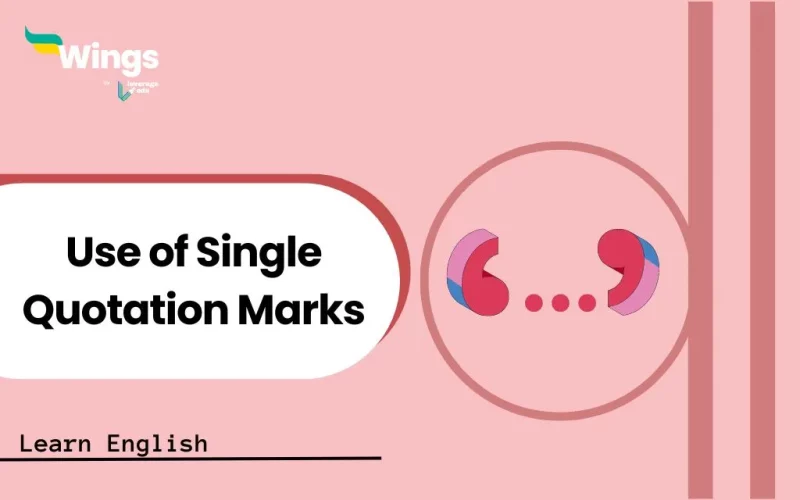Quotation marks, consisting of a pair of inverted commas, play a vital role in written English. But have you ever encountered a sentence with single quotes (‘ ’) and wondered, “What’s going on here?”. Often overlooked, they serve as guardians of direct speech, quotes, titles, and more. So, understanding their nuances can elevate your writing from good to great. In this blog, you will get to learn the use of single quotation marks in the English language along with their exceptions.
This Blog Includes:
Must Read: Punctuation: A Quick Guide
3 Primary Use of Single Quotation Marks
While double quotation marks are the workhorses for regular dialogue, single quotation marks serve a more specific purpose in certain contexts. Here are the key scenarios where they come into the picture.
Quotes within Quotes
It primarily comes into use when nesting quotations or indicating dialogue within dialogue. Imagine a situation where a character is quoting someone else within their own dialogue.
| For example: The teacher said, “Remember Benjamin Franklin’s famous quote, ‘Early to bed, early to rise, makes a man healthy, wealthy, and wise’?” |
In this sentence, the outermost quotation is denoted by double quotation marks, while the inner quotation is encapsulated within single quotes. This nesting prevents confusion, clearly delineating the different levels of dialogue.
Title of Short Works
Single quotes are often used to highlight the titles of short works like poems, songs, articles within a larger publication, chapters of a book, or short stories.
| For example: I particularly enjoyed reading Robert Frost’s poem, ‘Stopping by Woods on a Snowy Evening.’ |
Emphasis in Informal Writing
In informal writing or dialogue, some writers use single quotes to emphasise a particular word or phrase. However, this usage is not considered grammatically formal and should be used with caution, particularly in academic writing.
| Informal Example | Formal Example |
| This movie was ‘life-changing’! | This movie was life-changing. |
Exceptions and Errors in the Use of Single Quotation Marks
While single quotation marks have their designated roles, there are exceptions to their usage, particularly when dealing with titles of works or emphasising certain words or phrases. In titles of books, articles, poems, and other standalone works, double quotation marks are the convention. For instance: She recently read “The Great Gatsby” and found it captivating.
Single Quotation Mark Errors
You should also not overlook the following point while using single quotations to avoid any potential error:
- Single quotation marks should not be used for regular dialogue or standalone quotes.
- While some informal writing uses single quotes for emphasis, it can be seen as unprofessional and distracting when overused. Consider alternatives like italics, bold text, or stronger word choice for emphasis in formal writing.
- Single quotes are not typically used for titles of full-length books, plays, or movies. These titles are usually italicised.
- Single quotes do not replace apostrophes for possessives (‘s) or contractions like don’t, can’t. Won’t, etc.
Quotation Marks in American English vs British English
By now you must be aware of all the rules that apply with single quotation marks. Similarly, all of these apply to quotation marks in America— the majority of it applies in places like Canada, Australia and New Zealand. But does this rule apply to British English as well?
Well, one must note that Quotation marks in British English reverse single and double quotation marks, so single quotation marks are used as usual. While the double quotation quotes are used only for a quote within a quote.
Take a look at the examples below to understand the usage of both types of quotation marks and how they are used in sentences for both American and British English.
American English: “The doctor told me, ‘An apple a day keeps the doctor away,'” and recommended to have one daily.
British English: The plumber told me, “The tap is broken,”‘ and went away.
Apart from this, all the other rules are the same.
Find more Punctuational Reads Below!
This was all about the use of single quotation marks and related information. Hope you understand the concept and know how to proceed. You can also follow the page of Learn English on Leverage Edu website for more exciting and informative blogs.
 One app for all your study abroad needs
One app for all your study abroad needs














 45,000+ students realised their study abroad dream with us. Take the first step today.
45,000+ students realised their study abroad dream with us. Take the first step today.

